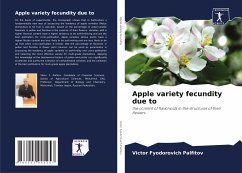On the basis of experiments, the monograph shows that in horticulture a fundamentally new way of assessing the tendency of apple varieties (Malus domestica) to tie fruit is possible, based on the percentage of water-soluble flavonols in pollen and florizine in the columns of their flowers. Varieties with a higher flavonol content have a higher tendency to be self-fertilising and are the best pollinators for cross-pollination. Apple varieties whose pistils have a higher florizin content are less likely to be self-inviting and are less likely to tie up fruit when cross-pollinated. It follows that the percentage of flavonols in pollen and florizine in flower pistil columns can be used as parameters in assessing the tendency of apple varieties to self-fertility and cross-pollination and selecting the most effective variety for multi-grade plantations. Applying this knowledge of the biochemical factors of pollen and pistils can significantly accelerate and justify the selection of self-pollinated varieties and the selection of the best pollinators for multi-grade apple plantations.
Bitte wählen Sie Ihr Anliegen aus.
Rechnungen
Retourenschein anfordern
Bestellstatus
Storno

